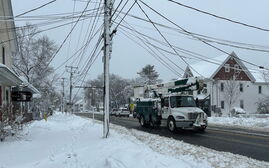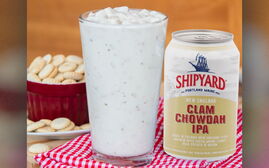Processing Your Payment
Please do not leave this page until complete. This can take a few moments.
- News
-
Editions
-
- Lists
-
Viewpoints
-
Our Events
-
Event Info
- Business Leaders of the Year Reception 2025
- Women's Leadership Forum 2025
- On the Road with Mainebiz in Bethel
- Health Care Forum 2025
- On The Road with Mainebiz in Greenville
- On The Road with Mainebiz in Waterville
- Small Business Forum 2025
- Outstanding Women in Business Reception 2025
- On The Road with Mainebiz in Bath
- 60 Ideas in 60 Minutes Portland 2025
- 40 Under 40 Awards Reception 2025
- On The Road with Mainebiz in Lewiston / Auburn
- 60 Ideas in 60 Minutes Bangor 2025
Award Honorees
- 2025 Business Leaders of the Year
- 2024 Women to Watch Honorees
- 2024 Business Leaders of the Year
- 2023 NextUp: 40 Under 40 Honorees
- 2023 Women to Watch Honorees
- 2023 Business Leaders of the Year
- 2022 NextUp: 40 Under 40 Honorees
- 2022 Women to Watch Honorees
- 2022 Business Leaders of the Year
-
-
Calendar
-
Biz Marketplace
- News
- Editions
- Lists
- Viewpoints
-
Our Events
Event Info
- View all Events
- Business Leaders of the Year Reception 2025
- Women's Leadership Forum 2025
- On the Road with Mainebiz in Bethel
- Health Care Forum 2025
- On The Road with Mainebiz in Greenville
- + More
- On The Road with Mainebiz in Waterville
- Small Business Forum 2025
- Outstanding Women in Business Reception 2025
- On The Road with Mainebiz in Bath
- 60 Ideas in 60 Minutes Portland 2025
- 40 Under 40 Awards Reception 2025
- On The Road with Mainebiz in Lewiston / Auburn
- 60 Ideas in 60 Minutes Bangor 2025
- - Less
Award Honorees
- 2025 Business Leaders of the Year
- 2024 Women to Watch Honorees
- 2024 Business Leaders of the Year
- 2023 NextUp: 40 Under 40 Honorees
- 2023 Women to Watch Honorees
- 2023 Business Leaders of the Year
- + More
- 2022 NextUp: 40 Under 40 Honorees
- 2022 Women to Watch Honorees
- 2022 Business Leaders of the Year
- Nomination Forms
- Calendar
- Biz Marketplace
Tech investments fortify ski season for Maine resorts
 photo/Tim greenway
Greg Sweetser, executive director of the Ski Maine Association, says technology has given a real boost to Maine's $300 million ski industry
photo/Tim greenway
Greg Sweetser, executive director of the Ski Maine Association, says technology has given a real boost to Maine's $300 million ski industry
Greg Sweetser has seen all manner of winter's weather-related ups and downs.
From his first job as junior ski patroller at Mt. Abram, to manager of sales and marketing of Saddleback Ski Area and, since 1996, as the executive director of the Ski Maine Association, he has spent his career in the winter sports industry. Along the way he's learned that the effects of a changing climate and the challenges of turning a profit in unpredictable circumstances are part of the business.
Technology has allowed many of Maine's ski areas to offset some of the recent effects of warmer-than-usual winters. Sunday River and Sugarloaf have made substantial off-season investments in new snow-making equipment to start the season despite a lack of natural snow.
Mainebiz recently sat down with Sweetser to talk about Maine's $300 million industry. The following is an edited transcript.
Mainebiz: What impact did the investment by Sunday River and Sugarloaf have on the industry?
Sweetser: They certainly set the standard by each being able to invest $1 million in new snow-making technology. Both Sugarloaf and Sunday River took a huge leap this year with 300 guns each. But Camden Snow Bowl, Lost Valley, Black Mountain, Herman Mountain in Bangor have all taken advantage of the same technology advances, which present the same type of impact. The last week of November was really a testament to all this improvement because the temperatures were perfect snow-making temperatures — we were in the single digits and teens. On Dec. 1, because of some advantages of electric rates, we had 10 ski areas making snow. To have 10 ski areas making snow on Dec. 1 is pretty unprecedented. Because they can run more guns at marginal temperatures, it was worth starting production.
How long has snow-making been the main tool in combating the effects of climate change?
Snow-making has certainly been the primary focus for the last two decades. Dealing with weather and temperature swings is nothing new. The ski industry started in Maine with lift service skiing in 1936 on Jockey Cap in Fryeburg and 1937 was the warmest winter on record [to that point in history]. So year No. 2 in Maine's ski season was the biggest melt-down ever. Ever since then people have been trying to mitigate the effects of the weather.
What effect has the economy had on the winter sports industry?
This is an interesting business and we've said many times that the amount of snow overrides the economy. The economy is critical and you can feel the strain and the stress. But for the core skier, the season pass holder, that market hasn't wavered through the recession because skiing is a participatory sport and people are passionate about it. You can only do it in the winter when it snows and people are going to find ways to make it happen.
Has there been a predominant trend in the industry?
The encouraging thing is that the community areas have been receiving tremendous local support right now. In the '70s, the ski industry was really growing and people moved away from the backyard ski areas.[But] the community areas that survived are now vibrant. [People patronize local ski areas] kind of like the buy local concept in agriculture.













Comments